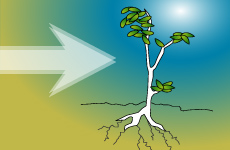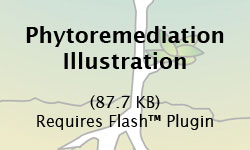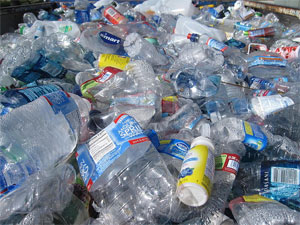Marisa Margaretich was a senior majoring in Environmental Engineering when she wrote this article. She was also the Vice President of Programming for the University Residential Student Community. In the future, she would like to attend law school with an emphasis on environmental law.
The natural environment is very easily polluted by the toxic compounds contained in oil. In the past, methods for restoring contaminated areas have been expensive but largely inadequate. A recently developed decontamination process called phytoremediation uses plants along with the bacteria that live in their roots to break down the toxins directly, or to absorb them so that they can be removed more easily. The applications of phytoremediation are extensive and extend from your corner gas station to oil refineries to military bases. The role of engineers in designing these sites to maximize their cleaning efficiency is very important. Choosing the plants, enhancing the process, and combining phytoremediation with other techniques are just a few of the tasks whose outcome helps determine the overall succeess of the treatment.
Introduction
Petroleum products are an essential part of everyday life. The gasoline that powers your car and the plastic jug that stores your milk are both made from oil. Unfortunately, these convenient products come at a high price to the environment. From the refineries that process crude oil to the filling stations that deliver gasoline and diesel fuel, oil pollutes most of the things with which it comes into contact. Therefore, cleaning up the mess is very important.
William Shakespeare once said, “All the world’s a stage.” Well then, in a world contaminated by oil, bring in the stagehands. In the past, when a piece of land became polluted with oil, engineers had several options for cleaning it up, but most of these options were very expensive. In addition, they usually only moved the problem from one place to another. Therefore, in the last decade there has been a great deal of interest in a new technique called phytoremediation (Fig. 1). Phytoremediation – using plants to mitigate contamination – is an exciting prospect for treating oil-related pollution in soils.
What exactly is Phytoremediation?
In the most basic sense, phytoremediation is the use of plants to speed up the process of cleaning chemically contaminated areas [1]. There are several different types of phytoremediation, each relying on a different plant process (see flash demo).
Phytotransformation begins with the plant absorbing through its roots contaminants in the soil or water. Then as the plant goes about its normal activities, it transforms the contaminant into something less toxic [2].
Phytoextraction also relies on the absorption of toxins into the body of the plant; however, in this process the plant does not change the pollution into something else. Instead its leaves, stalks and/or trunks of the plants become concentrated storage containers for toxic substances, which can be then safely removed from the area [2].
Phytostablization involves less cleaning and more stabilizing. The plants do not remove any contamination or aid in the process of breaking it down into something less toxic, but rather prevent the spread of the pollution to other areas by holding the dust and soil in place with their root systems. This technique also has the advantage of preventing humans from inhaling dust that may be hazardous to their health [2].
Rhizofiltration uses plant roots as a filter to trap contaminants so that they can be removed more easily [2].
Rhizosphere bioremediation gives the plants themselves an indirect role as hosts for bacteria and other tiny organisms that perform the actual decontamination. The plants’ main purpose in this method is to encourage the growth of these small organisms by providing a root structure and a supply of nutrients [2].
Applications of Phytoremediation
Oil refineries are a critical step in transforming oil from the thick black substance pumped out of the ground to the products people use in their daily lives. But what happens to all the oily waste that such a refinery creates? When a refinery is permanently closed, what can be done about the surrounding land, which has likely been soaking up oil pollution for many years?
Environmental engineers work in conjunction with oil companies to develop cleanup plans for contaminated sites. Phytoremediation is attractive to environmentalists and businesses alike due to its low cost and high efficiency compared with other treatment methods. Moreover, the plants brought in for phytoremediation projects add a pleasing visual aspect to areas that are usually very industrial [3].
While it is important to clean up the areas where oil is refined, the danger of contamination exists wherever petroleum or one of its related products is handled or distributed. Your local gas station, for example, can pollute the surrounding soil in several ways. First, the slight dribble of oil that sometimes falls from the tip of the gas pump to the ground can have significant cumulative effects over time. Second, inadequate maintenance of the storage tanks underneath the station, along with earthquakes and other natural threats, raises the possibility of underground fuel leakage – potentially a much more serious concern. A great deal of research is currently being conducted to extend the usefulness of phytoremediation to filling stations and other distribution points.
One example of this research is a previously contaminated site where a Purdue Universtiy team of scientists and the EPA have created a friendly competition to compare phytoremediation with traditional techniques. The university researchers are using plant life to treat their portion of the site, while the EPA is using more conventional methods. The ultimate goal of the project is to gather hard data on the relative effectiveness and real-world cost of different cleanup techniques [4]. In the future, when a gas station closes in your neighborhood, you will most likely see plants acting in the interest of making that site a cleaner place.
The Engineer’s Job
Just as an actor’s performance is enhanced by the comments of a director, a plant’s performance can be enhanced by the design of an engineer. Designing a cleanup plan is a complicated task, and environmental engineers have to make decisions concerning the type or types of plant to use, how best to implement the phytoremediation process, and how best to combine phytoremediation with other techniques to achieve maximum results.
The most important decision facing a cleanup engineer is the choice of plant. There are many factors to consider, including climate, soil, root type, and how well different species handle different types of pollutants. Climate is also a major factor, since a plant that grows in Florida may not be as successful in Alaska; for phytoremediation to work, the plants have to survive and flourish. Soil type is important for similar reasons, since plants generally prefer a certain kind of soil, such as clay or sand [5]. Root type is yet another consideration: plants with lots of small roots are better for reaching every tiny crevice of soil than most trees, which typically have much larger roots [4]. Perhaps the most essential criterion for choosing a plant is how well the plant degrades the oil products. If the plant can chemically change the oil into something less toxic, there are no further concerns. However, if the plant simply accumulates the oil in its various structures, then it must eventually be harvested and properly disposed.
Environmental engineers must additionally decide how they can enhance the clean-up process. In other words, the engineers must be conscious of how they can help the plants do their job better. One option is to change the genetics of the plant, although this is not usually necessary. Sometimes the best way to improve the process is simply to give the plant the nutrients it needs; adding fertilizer, water and other agents can be very effective in this regard. Another good way to help the process along is to decide on a particular pattern and number of plants for a given area. By fine-tuning the process, the engineer ensures that contaminated areas will be as clean as possible in the end.
Finally, engineers must also assess the applicability of other cleanup techniques in conjunction with phytoremediation [3]. Phytoremediation may prove inadequate on its own because of inherent limitations on plants’ ability to clean: first, plants must survive in the environment if they are to do their job; and second, they can only treat the pollution they can reach. If the soil is too toxic, the plants will die; on the other hand, if the contamination is deeper than approximately nine feet, the plant roots may not be able to reach it. Digging up the polluted soil, combining it with uncontaminated earth, and spreading the mixture out over a larger area can solve both of these problems.
By choosing the right plant, enhancing the plants’ abilities, and combining phytoremediation with other technologies, the engineer clearly demonstrates his or her importance in designing the best possible strategy for treating a contaminated area.
Conclusion
While oil and its related products play an integral part in everyday life, it is important to remember that the convenience of these commodities comes at a high cost to the environment. The widespread deployment of phytoremediation will mark the beginning of a truly important stage in our relationship with the environment, since it will allow us to reverse pre-existing damage to soils. The work of engineers in developing and refining these processes is of paramount importance if plants are to play their part successfully.
References
-
- [1] Giorgio Andreotti and Nadia Plata. “Phytoremediation of Hydrocarbon-Polluted Agricultural Soils.” International In Situ and On-Site Bioremediation Symoposium. Batelle Press, pp. 41-51, 2001.
- [2] Jerald L. Schooner. “Phytoremediation – Technology Evaluation Report.” Ground-Water Remediation Technologies Analysis Center. Internet: http://www.gwrtac.org/pdf/phyto_e.pdf, Oct. 1997 [22 June 2003].
- [3] Phytoremediation and Reuse. CH2M HILL. Internet: http://www.ch2m.com/phyto/SoilGroundwtr.htm, 21 June 2003.
- [4] Robinson Shaw. “Researchers get the root of soil remediation.” Environmental News Network (ENN). Internet: http://www.enn.com/enn-news-archive/2000/07/07112000/phytopetro_14632.asp, 11 July 2000. [18 June 2003].
- [5] Xiujin Qui, Thomas W. Leland, Sunil I. Shah, Darwin L. Sorenson, and Ernest W. Kendall. “Field Study: Grass Remediation for Clay Soil Contaminated with Polycyclic Aromatic Hydrocarbon.” Phytoremediation of Soil and Water Contaminants. ACS, pp. 186-199, 1997..
- [6] Jamie L. Bankston, J. Tom Duffey, and Al W. Bourquin. “Innovative Approaches for Groundwater Remediation Using Natural Attenuation and Phytoremediation.” International In Situ and On-Site Bioremediation Symoposium. Batelle Press, pp. 33-40, 2000.
- [7] M. Yavuz Corapcioglu, Clyde Munster, Malcom Drew, Robert Rhykerd, Kijune Sung and Yoon-Young Chang. “Phytoremediation and Modeling of Land Contaminated by Hydrocarbons.” Phytoremediation and Innovative Strategies for specialized remedial applications. Battelle Press, 1999.
- [8] Kevin R.Hosler and Evelyn N. Drake. “A Greenhouse-Based Test of Plant-Aided Petroleum Hydrocarbon Degradation.” Phytoremediation and Innovative Strategies for specialized remedial applications. Battelle Press, pp. 27-31, 1999.
- [9] L. G.Stehmeier, S. Leong, M. Salam, F. VanDelft, J. Kuhwald. and M. McD. Francis. “Phytoremediation of Oil-Contaminated Soil for Landfarm Sustainability.” International In Situ and On-Site Bioremediation Symoposium.Batelle Press, pp. 53-60, 2001.






